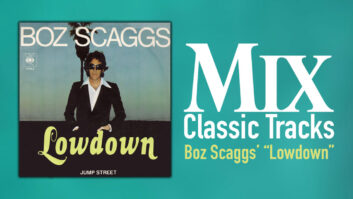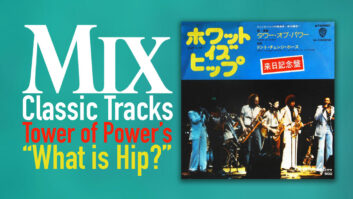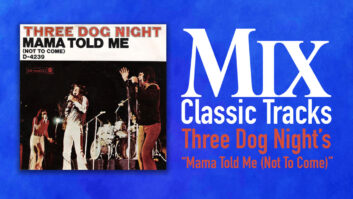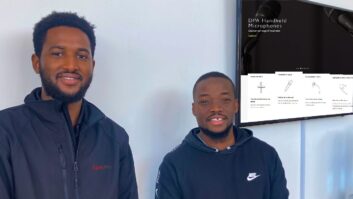by Christopher Walsh.
Anaheim, CA–“Vocals are the most important thing,” producer Ross Hogarth declares. “Obviously, the song is built on the vocal, so picking your vocal mic is absolutely crucial and of utmost importance.”
As members of the professional audio industry, including engineers and producers, artists and retailers, gather at the Winter NAMM Show, those interested in studio vocal microphones enjoy near-limitless choices. Long-lived standbys span a wide range in type and price–Neumann condensers and Shure dynamics both remain popular–while many newer, boutique models have been eagerly adopted by recordists and artists.
When it comes to recording vocals for professional projects, Hogarth speaks for all, though “quality” means different things to different ears. Fortunately, designers and manufacturers have developed enough high-end microphones to allow exhaustive comparisons and informed choices.
“I recently bought David Bock’s 250 version [Bock Audio 251],” says Hogarth. “I have my own [AKG] C12 that he’s looked at. Dave Pearlman is making a Church mic–back when I was working on REM with Don Gehman, he had a pair of Pearlman Church mics. There’s something about those that is just magical. I use the Mojave [Audio] tube mics a lot, and have used those on vocals on occasion.”
“I keep coming back to the old standbys,” says engineer Rich Breen. “[Neumann] U 47, M 49, AKG C12, Telefunken 251. Of course, good versions of any of these mics are hard to find. The Wunder CM7 is a very nice sub, and I haven’t heard [Wunder’s] CM49 yet, but if it’s anything like the CM7 I’m sure I’ll love it.
“The CM7 has such wonderful midrange projection,” Breen adds, “and to my ear works best on male vocal. For a sibilant male vocalist I usually prefer the less pronounced top end of the M 49–if I had to pick one vocal mic that always sounds good to me it would be the M 49. There are very few new ‘vocal’ mics that I like. The Brauner VM1 sounds good to me when I’ve mixed tracks recorded with it, as does the [Brauner] Valvet.
Like Breen, producer David Kahne is a fan of the Wunder CM7. “It’s a bit brighter than many 47’s,” he observes, “but with no loss on the low side.
“I usually use a U 47 for vocals,” Kahne notes, “as I find that’s the best all-around mic for my taste. Other vocal mics I use are the Shure 58, and the Violet Flamingo, which is somewhat like a 47 but with a different kind of body to the sound. It’s a little too thick at times for some singers, but for some it’s perfect.”
Indeed, inexpensive Shure dynamics, used in so many applications, are often the “correct” choice, many agree. “I can tweak the hell out of a Shure Beta 58,” says Jason Marcucci, chief engineer at New York’s Dubway Studios. “Recently, I do a lot of iTunes Live from SoHo sessions, and I use those on that, because of the rejection. I’ve done a couple rock bands in the studio and given the guy the 58 and they run around and go nuts. It sounds great! I can compress the hell out of it, and if you EQ it right it sounds like a really expensive mic.”
As all of these professional attest, performance trumps technology in importance. “That’s why I started doing it,” Marcucci explains. “You already have them on headphones. A lot of rock bands, even when they’ve cut some records or record at home, are not as comfortable [in a studio]. You don’t want to give somebody a $3,000 mic and have them jump around. If you have them standing still, it takes five times as long to start getting them to ‘performance’ level. A Beta 58 is good for that kind of thing.”
Hogarth relates an experience recording Patrick Simmons of the Doobie Brothers. “I was recording him on my 67, which sounds amazing on him. But on one song, a light, sort of soft ballad, [producer] Ted [Templeman] said, ‘On these kinds of songs, I always used a dynamic on Pat, because it makes him sound tougher.’ Which was interesting, because I was thinking on this song, the 67 was really going to shine. So I put up a 57, a 58, then remembered that I have these new Heil mics that Bob Heil had given me. I had only been using them on guitars and instruments. I put up a couple of his mics, and the PR-20–that’s supposedly the hand-held–killed on Pat. It had the brightness, but it had the dynamic sort of compact sound that Ted was requesting. So I had my eyes opened, because in general, my attitude when doing vocals is, ‘I’ll put up the expensive mics.'”
“It is different for every voice,” agrees producer David Barbe. “I vary mics and pres according to the voice, the song, or what tonally will fit in the mix. My choices are numerous: Super hi-fi–Lawson L251 [and] Microtech-Gefell UM92; rock ‘n’ roll thud–[Shure] SM7; midpoint between the two–[Audio-Technica] AT4047; old and fuzzy–RCA 77DX.
“I also, at times, use a Neumann KMS 105, a Lawson L47, or an Electro-Voice 635A,” Barbe adds. “Some folks just can’t loosen up with an expensive tube mic hanging in front of them, and do better with the SM7 or something less intimidating. That mic also does a great job smoothing out any piercing frequencies.”
A relative newcomer, Blue Microphones, is also give recordists a variety of options. “My vocal mic of choice for the last few years is the Blue Bottle,” says engineer Shane Wilson. “I have it and the B0, B6 and B7 capsules. When I first got it, I was pleasantly surprised how the three capsules really do give me three completely different sounds. The B0 provides a very bright tone, the B6 has a pleasant top end and good body, and the B7 is much warmer and darker. I find myself gravitating to the B6 for many different vocalists and the B7 for those with a brighter or thinner voice.”
Another newcomer draws interest from audio professionals. “Not too long ago I had a chance to test drive the JZ Black Hole,” says Cliff Goldmacher, who has studios in New York and Nashville. “While I might not use it in all vocal recording situations, I found it to be a really well designed mic with a natural brightness to it which makes it extremely effective on darker vocals.”
Goldmacher is also partial to multiple condensers. “In my New York studio where I do a lot of vocal overdubs in a very controlled environment,” he explains, “my vocal mic of choice for the last few years has been the Lawson L47MP. When I upgraded my vocal chain, I was looking for a mic that sounded balanced, warm and full and left me the least amount of work to do on the vocal sound in the final mix. The Lawson delivers beautifully. It’s got a balanced tone that works on both male and female vocals, bringing clarity to darker vocals and warmth and roundness to brighter/edgier vocals. It’s a superb all-around vocal mic.
“In my Nashville studio,” Goldmacher adds, “I’ve been using the Shure KSM44 mic through a Manley Vox Box. I’ve been extremely pleased with the results there, too. The Shure, although not a tube mic, has a nice balanced tone and the Manley delivers that little bit of extra warmth necessary to round out the tone. Again, I take a unisex approach and don’t feel the need to switch it out depending on the vocalist I’m recording.”
In addition to the “usual suspects”–original U 47, U 67 and Ela M 250 mics–Paul Antonell of the Clubhouse in Rhinebeck, NY uses “my new favorite, [the] AEA-440. It is extremely quiet, and has amazing sound. I think this is the new standard in ribbon technology.”
Marcucci adds that he has recently been recording vocals with a ribbon mic, the Crowley & Tripp Naked Eye. “That’s an amazing mic,” he says. “It’s got this Roswellite ribbon, it’s really sweet. People have been using it on bass and other instruments, but I’ve been using it on vocal. It’s not hyped, and it takes plug-in compression and lots of compression really well. I think you’re going to see a lot more people using those.”
“As much as I love the pictures of Frank Sinatra and Nat ‘King’ Cole in front of [RCA] 44s, I’ve never made that work,” Hogarth says of ribbon mics. “Every time I do it, it seems like ‘I have to roll off everything below 100 [Hz], and add all this top.’ But on the counter side of that, I think we have gotten used to things that are way too bright. To me,” he concludes, “it really comes down to mics that are not super-shrill and add a lot of sibilance.”







